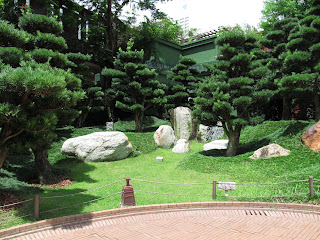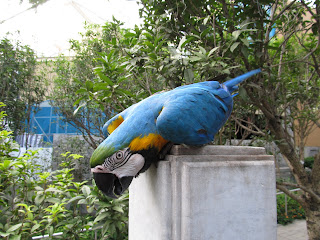When I first read Martin Booth's memoir
Gweilo, his descriptions of Hong Kong in the 50s fascinated me. In particular, his description of Kowloon Walled City grabbed my attention, because I felt it truly described a Hong Kong which doesn't really exist anymore. Indeed, Kowloon Walled City was torn down in the 1990s.
Kowloon Walled City started life as a Chinese military outpost. Even when the New Territories were leased to Great Britain, the city technically remained under Chinese rule. When the British eventually claimed it, they found the village almost empty apart from an old Mandarin. By the middle of WWII, very little remained of the city except the historic yamen and a few other buildings. After the end of WWII, the Chinese government announced their intent to reclaim the Walled City, and thousands of refugees took over the area under the Chinese protection. The British Government attempted to get rid of the Chinese unsuccessfully, and after that adopted a hands-off policy.
With this hands off policy, Kowloon Walled City became a haven for triads and criminals, as well as normal Hong Kong families. Home industries thrived, and even up until its demolition in 1993, the city was well known for dentistry, though the dentists were largely unlicensed. As far as illegal activity goes, opium dens, prostitution and gambling also thrived in the City.
Here is Kowloon Walled City in 1980, 13 years before demolition:
As you can see, it was a very small space that was very densely packed. Many of the buildings had pathways through them so that it was possible to go from one side to another without actually touching the ground. Building was pretty much unregulated, and apartments were on average 250 square feet. Balcony cages and rooftop additions were a common way of creating more space.
Inside the old city walls now lies a park. This park is based on some classical Qing period gardens, and includes the old Yamen building, which was painstakingly restored after the demolition.
It's a really beautiful place now, and it seems very hard to believe that what used to be there was quite an infamous place. In Booth's memoir, he says that "It was said that any European who entered is was never seen again unless floating out of it down the
nullah that served as a sewer. If ever the police entered the area, they went in armed patrols of three." (Booth, M.
Gweilo, 2006) It certainly paints a picture of what it was like 50 years ago. The park was full of old people, and I had to wonder if they had once been residents of the Walled City, relocated by the government before the demolition.
In the yamen, there are a few displays of photos, models and graphics about the city, its history and its culture. This photo is a rendering of a map of the city in the 1970s. All above ground passageways, staircases, wells, entrances and factories are marked. You can see from the picture just how crowded and cramped the area was, but also get an idea of how life function is what was essentially a closed community.
This is a bronze model of the city as it was just before demolition in 1993.
Looking over the model to the doors of the yamen.
Behind the bronze model, there was a large cross section picture showing aspects of daily life in the walled city. Above, a dancer entertains men in a bar.
An illegal dentist does his work, while at the right, old men gossip with their birds and friends.
Neighbours tear down the adjoining walls to make a bigger apartment.
While another family extends by simply building up.
A prostitute plies her trade in a small room.
And a man is threatened with a gun for some unknown crime.
This place is well worth a visit. It's not exactly on the beaten track for many tourists, but can be easily reached on the number 1 bus from Tsim Sha Tsui. Kowloon Walled City was a place that combined, seamlessly, aspects of both every day life in Hong Kong, and the seedier underside of it. I won't say my quest for information on this place has been completely fulfilled, but it is certainly good to understand a little bit more of another aspect of Hong Kong life pre-handover.






















































